The conical bottom is a 60° angle from the cylinder wall. The slope is
just the right angle so the trub, dead yeast cells, and everything falling
out of suspension will slide to the bottom at the apex of the cone. The trub
can be drained with a minimum waste of good beer. No siphion is needed when
racking as the side port is always below the bier line.
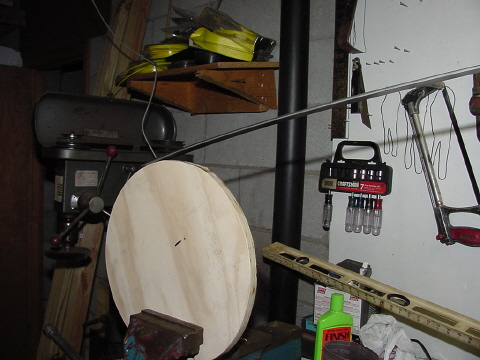
I started out with a piece of 1 1/2"
x 3/16" x 6' steel bar bent around
a 3/4" plywood form the diameter of
the fermentor. I then opened my vice
6 inches and layed the semi round
ring across the opening. Hammering
and rotating the ring, at the center
of the vice, until it was close to
the plywood form.
|

The semi ring was measured, cut and
welded together to form a complete ring.
At this point the ring was slid over
the fermentor. Then the high and low
spots were hammered out on the vice
until the ring slid over and down to
the lid opening with no binding.
|
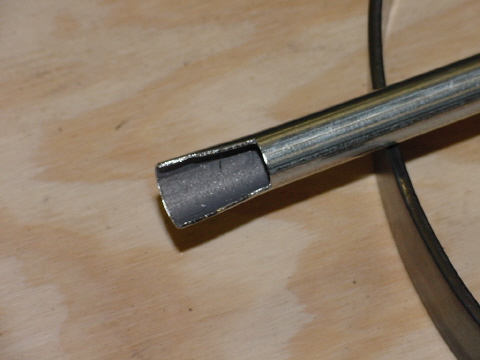
To cut costs, I used 1/2" electrical
conduit to make the legs and support
trusses. Each leg was notched and
flattened slightly to clear the
fermentor body.
|

Each leg was clamped and trued vertical
before being welded at 120 degrees
apart around the ring.
|

The fermentor was then slid down into the
emerging stand and dimensionally checked
for clearance and fit.
|
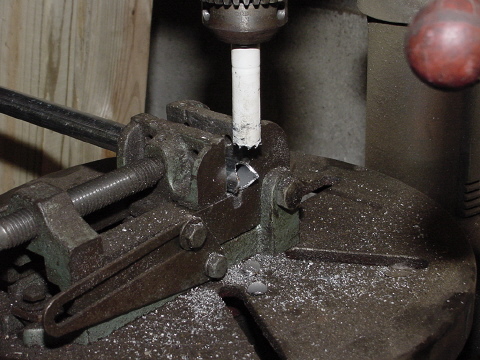
Once proper fit was established it was
time to fabricate the support trusses.
Three pieces of 1/2" electrical conduit
were cut to rough fit. With the help of
a 5/8" bi-metal hole saw chucked into a
drill press, I cut each support truss
to form half moon ends.
|
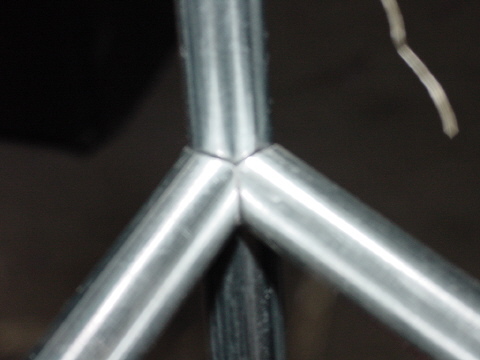
Two cut per end were needed to make the
ends match up nice and snug. A little
de-burring and filing cleaned things
up for welding.
|

The support trusses were then fitted on
the vertical legs, leveled and tied off
with binders twine to hold them in place.
Each truss is tack welded in preperation
for the final weldng.
|
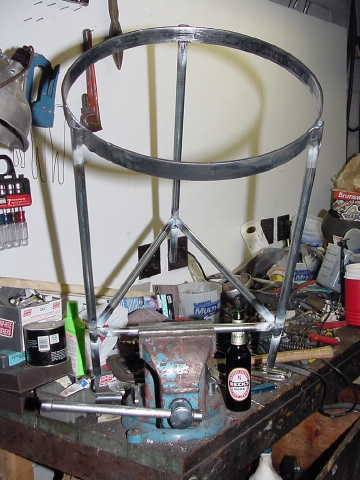
Once the tack welding is done, the stand
is then transfered to the vice for final
welding. In the vice, it can be repositioned
in any angle for the best access. Note the
Becks Dark in the backround. My inspiration
for this entire project.
|
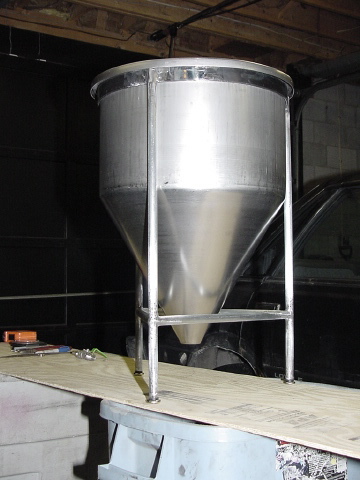
Here is a look with the hopper body
dropped into the welded stand. It nice
when a plan comes together.
|
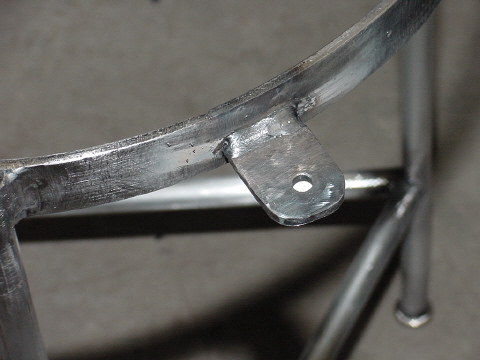
The next task at hand are the tabs
that hold the clamping bar to the stand.
I used a left over piece of the ring to
make the tabs. There is nothing like a
1/8" full flow electrode at 175 amps to
lay down the near perfect bead.
|

The clamping bar is made from a piece
1 1/2" x 3/16" angle. A 1/4-20 threaded
connector is welded at the center for
the one of the leg pads to seat against
the top of the lid.
|
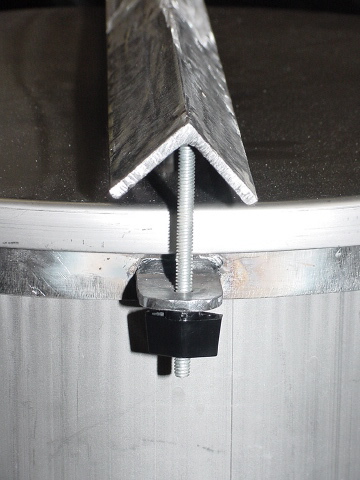
At each end of the clamping bar a hole
is drilled and taped. 1/4-20 thread all
is then screwed in and adjusted to height,
cut and tack welded from the top. Note the
thumb nut to adjust the clamping pressure.
|
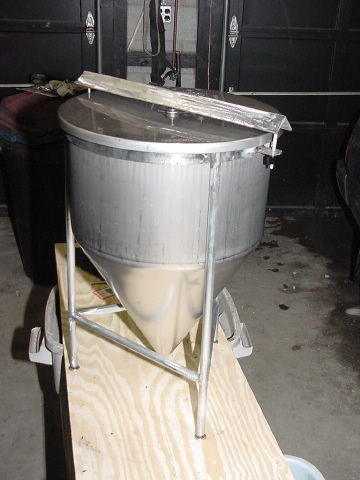
A view of the clamping bar in place. At
the bottom of each leg is a 1/4-20 nut,
fitted into the end and welded. This
provides the leg pads something to
screw into.
|

Here is a view of the stand after two
coats of primer and two coats of
texture paint.
|
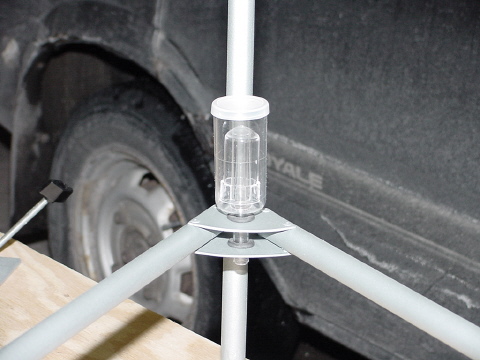
Here two aluminum plates are cut,
drilled for the 7/16" grommets
and pop rivited in place. If you
struggle for head space in the
refrigerator/lagering cabinet,
the air lock can be transfered
down here.
|
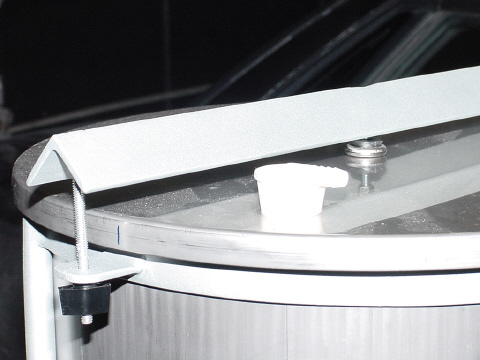
Here is a view of the Rubber stopper.
A 1 1/4" bi-metal hole saw was used to
cut the hole. The lid was clamped onto
the drill press table and lots of water
was used to cool the hole saw.
|
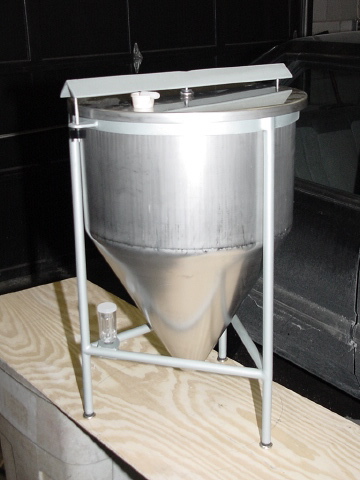
An Assembled view
|

Another assembled view
|

